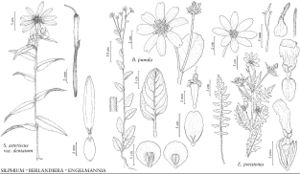Berlandiera
in A. P. de Candolle and A. L. P. P. de Candolle, Prodr. 5: 517. 1836.
| Taxon | Illustrator ⠉ | |
|---|---|---|
 | Silphium asteriscus Berlandiera pumila Engelmannia peristenia | Yevonn Wilson-Ramsey John Myers John Myers |
Perennials or subshrubs, 8–120 cm (stems often arising annually from taproots or woody caudices; herbage usually hirsute, hispid, scabrous, or velvety). Stems decumbent to erect, usually branched (scapiform or ± leafy throughout). Leaves basal and/or cauline; alternate; petiolate or sessile; blades (± pinnately nerved) elongate-deltate, lanceolate, lyrate, oblanceolate, oblong, obovate, ovate, or spatulate, sometimes pinnately lobed to pinnatifid (usually each with deeper sinuses proximal), bases cordate or truncate to cuneate, ultimate margins usually crenate, dentate, or sinuate, faces hirsute, hispid, scabrous, or velvety. Heads radiate, borne singly or in paniculiform to corymbiform arrays. Involucres ± campanulate to ± hemispheric or broader, 12–30 mm diam. (broader in age). Phyllaries persistent (outer) or falling, usually 14–22 in 2–3+ series (inner broadly obovate to orbiculate, hairy, shed with cypselae). Receptacles ± turbinate (distally dilated, apices flattened to slightly depressed), paleate (paleae ± linear-conduplicate, each wrapped round a disc-floret, distally dilated, hirtellous). Ray-florets (2–) 8 (–13), pistillate, fertile; corollas pale-yellow to orange-yellow (abaxially green or red to maroon or with 9–12, green or red to maroon, anastomosing, veins). Disc-florets 80–200+, functionally staminate; corollas yellow or red to maroon, tubes shorter than throats, lobes 5, ± deltate. Cypselae (black) obcompressed or obflattened, mostly obovate (thin edged, not truly winged, hairy, at least adaxially; each adhering to and shed with 2 adjacent paleae, 2 disc-florets, and a subtending phyllary); pappi 0, or persistent, ± coroniform (inconspicuous ridges or minute crowns of aristate teeth). x = 15.
Distribution
United States, Mexico
Discussion
Species 8 (8, including 3 hybrids, in the flora).
All Berlandiera species have 2n = 30 and all but perhaps B. monocephala (which was unavailable for study) are intercrossable, resulting in all possible artificial interspecific hybrid combinations. Some combinations are not found in nature, e.g., B. lyrata × B. subacaulis, because distributions of potential parentals do not overlap (D. J. Pinkava 1964, 1967).
Selected References
Lower Taxa
Key
| 1 | Leaf blades lyrate (pinnate to pinnatifid) or oblanceolate (seldom pinnate, ultimate margins mostly crenate), faces velvety; peduncles hairy (some hairs reddish, bulbous-based, wartlike); ray corollas: abaxial veins red to maroon; disc corollas usually red to maroon, rarely yellow | > 2 |
| 1 | Leaf blades deltate, lanceolate, lyrate, oblong, oval, or ovate, sometimes pinnately lobed to pinnatifid, faces hirsute, hispid, ± scabrous, or velvety (leaves not both oblanceolate or lyrate-pinnatifid and velvety); peduncles hairy (velvety to scabrous, and with wartlike hairs in B. subacaulis); ray corollas: abaxial veins green; disc corollas yellow or red to maroon | > 3 |
| 2 | Leaves usually lyrate-pinnatifid, rarely not lobed; peduncles hairy (relatively many red- dish wartlike hairs surpassing appressed, white hairs) | Berlandiera lyrata |
| 2 | Leaves mostly oblanceolate, usually some pinnatifid near bases; peduncles hairy (relatively few reddish wartlike hairs enmeshed in matted whitish hairs; plants intergradesbetween B. lyrata and B. monocephala) | Berlandiera ×macrophylla |
| 3 | Leaves crowded near bases of stems; heads borne singly or 2–3 together; disc corollas yellow | > 4 |
| 3 | Leaves crowded near bases of stems or ± evenly distributed on stems; heads borne singly or 2–20 in paniculiform to corymbiform arrays; disc corollas red to maroon | > 5 |
| 4 | Leaf blades oblanceolate (usually not lobed, sometimes lobed at bases, ultimate margins crenate to remotely dentate), faces velvety; peduncles hairy (hairs whitish,matted, none wartlike); Arizona (Sonora) | Berlandiera monocephala |
| 4 | Leaf blades mostly oblong (usually sinuate-pinnatifid), faces ± scabrous; peduncles hairy (hispid and with wartlike hairs); Florida | Berlandiera subacaulis |
| 5 | Leaves crowded near bases of stems (usually some leaves lobed basally, faces finely hirsute); peduncles hairy (hairs relatively long and fine mixed with shorter, stouter hairs; plants intergrade between B. pumila and B. subacaulis) | Berlandiera ×humilis |
| 5 | Leaves evenly distributed along stems (not lobed, faces sometimes finely hirsute); peduncles hairy (hairs not mixed long and short) | > 6 |
| 6 | Leaf blades usually ovate, faces velvety; peduncles hairy (hairs whitish, rela-tively long and fine, matted); South Carolina to Mississippi, e Texas | Berlandiera pumila |
| 6 | Leaf blades elongate-deltate, lanceolate, or ovate, faces finely ± hirsute to ± scabrous; peduncles hairy (hirsute or hairs grayish to reddish, erect or spreading, sometimes curling) | > 7 |
| 7 | Stems lax (sometimes suffrutescent); leaf blades (at least mid-stem) petiolate, narrowly to broadly ovate (widths 1/2–1 1/4 times lengths), membranous, margins, usually crenate, faces finely to coarsely hirsute; peduncles hairy (hairs grayish to reddish, erect or spreading, sometimes curling); intergrades to B. pumila and B. texana | Berlandiera ×betonicifolia |
| 7 | Stems (stiff) erect; leaf blades (at least mid-stem) petiolate to sessile, elongate-deltate to lanceolate (widths to 2/3 lengths), chartaceous, margins serrate to dentate, faces hirsute to scabrous; peduncles hairy (densely hirsute) | Berlandiera texana |
"broader" is not a number.